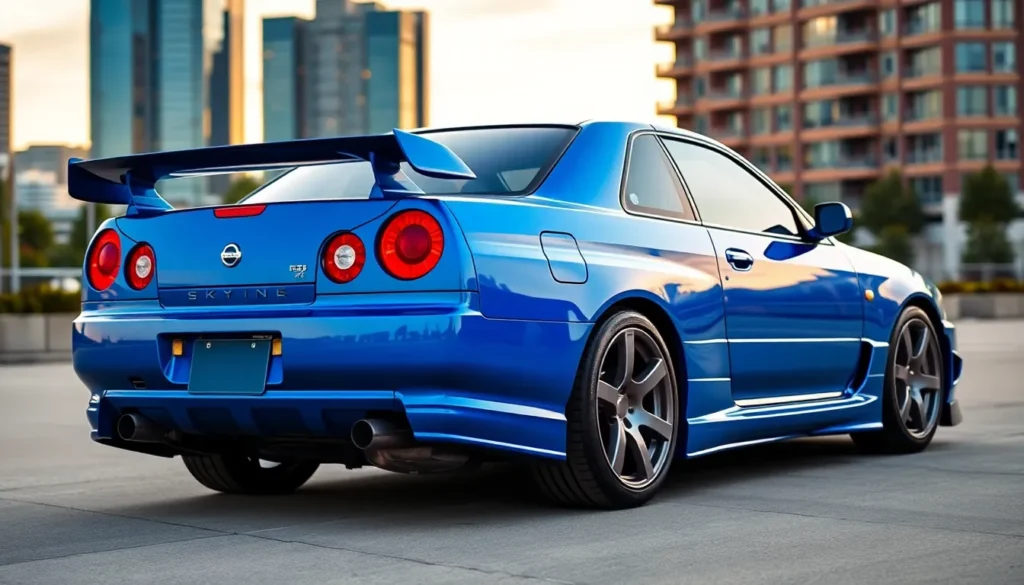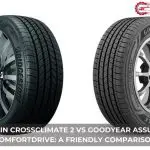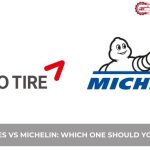The Nissan Skyline R34 isn’t just another sports car – it’s a legend that ignited the dreams of countless automotive enthusiasts worldwide. Released between 1999 and 2002, this iconic machine represents the pinnacle of Japanese engineering excellence and has become one of the most coveted vehicles in automotive history.
We’ve witnessed how the R34’s distinctive design language and cutting-edge technology transformed it from a mere production car into a cultural phenomenon. Its aggressive stance, signature quad taillights, and unmistakable silhouette have made it instantly recognizable to car lovers across the globe.
What makes the R34 truly special isn’t just its stunning looks – it’s the perfect fusion of raw performance and technological innovation that defined an era. From its legendary RB26DETT engine to its advanced ATTESA E-TS all-wheel-drive system, every component was engineered to deliver an unforgettable driving experience that continues to captivate enthusiasts decades later.
What Makes the Nissan Skyline R34 Special
The RB26DETT engine stands as the beating heart of what makes every R34 GTR exceptional. Twin turbochargers deliver 276 horsepower in stock configuration, though this figure represents a gentleman’s agreement among Japanese manufacturers rather than actual output limits. Engineers designed this 2.6-liter inline-six powerplant to handle substantially more power with minimal modifications.
ATTESA E-TS Pro all-wheel-drive system revolutionized traction management when Nissan introduced it in the R34 platform. Electronic torque distribution actively monitors wheel slip and road conditions 10 times per second. Front wheels receive power only when rear traction becomes insufficient, maintaining the rear-drive character that enthusiasts cherish while providing grip when conditions demand it.
Aerodynamic refinements distinguish the R34 from its predecessors through extensive wind tunnel testing. Nissan’s engineers reduced drag coefficient to 0.33 while increasing downforce across the rear spoiler and front splitter. Active rear spoiler deployment occurs automatically at speeds exceeding 80 mph, providing additional stability during high-speed cornering.
| Performance Metric | R34 GTR Specification |
|---|---|
| Engine Output | 276 hp @ 6,800 rpm |
| Torque | 293 lb-ft @ 4,400 rpm |
| 0-60 mph | 4.8 seconds |
| Top Speed | 155 mph (electronically limited) |
| Weight Distribution | 55% front / 45% rear |
Chassis rigidity improvements over the R33 model enhanced handling precision through strategic reinforcement points. Nissan added structural bracing in 47 locations throughout the unibody construction. These modifications increased torsional rigidity by 15% while maintaining curb weight at 3,153 pounds.
Electronic stability management integrates multiple systems including ABS, traction control, and torque vectoring. Super HICAS four-wheel steering provides rear axle steering input during cornering maneuvers. Rear wheels turn in the same direction as front wheels at speeds above 50 mph, reducing turning radius at lower speeds through opposite-direction steering.
Brembo brake calipers grip 324mm ventilated rotors at all four corners, providing fade-resistant stopping power. Heat dissipation channels within the rotor design maintain consistent pedal feel during track sessions. Brake assist technology detects emergency stopping situations and applies maximum braking force when sensors detect rapid pedal application.
Production limitations create the exclusivity that defines R34 ownership today. Nissan manufactured only 11,578 R34 GTR units between 1999 and 2002. Zero examples reached American showrooms during the original production run due to emissions regulations and crash testing requirements that didn’t align with US standards.
Performance and Engine Specifications
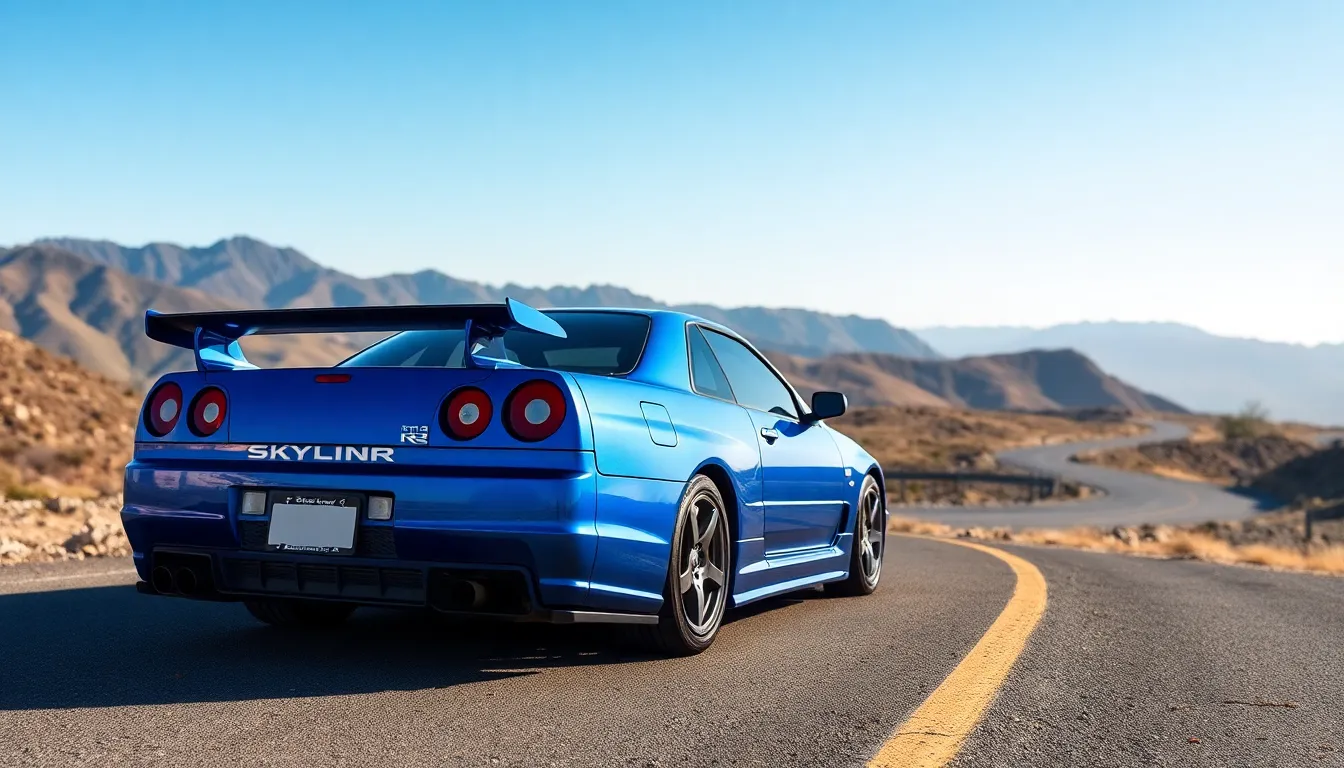
Performance specifications of the Nissan Skyline R34 showcase engineering excellence that transformed this sports car into a tuning legend. These technical achievements created a foundation for both street performance and motorsport dominance.
The Legendary RB26DETT Engine
The RB26DETT engine stands as the beating heart of the R34 GT-R, delivering impressive performance through advanced engineering. This 2.6-liter twin-turbo inline-six produces 276 horsepower and 293 lb-ft of torque in stock configuration, though this power figure represents a gentleman’s agreement among Japanese manufacturers rather than the engine’s true potential.
Forged internals within the RB26DETT include a robust crankshaft, connecting rods, and pistons that handle substantial power increases. Twin Garrett T25 turbochargers provide forced induction with minimal lag, while the aluminum cylinder head features individual throttle bodies for each cylinder. Electronic fuel injection and ignition systems optimize combustion efficiency across the rev range.
| Engine Specification | Value |
|---|---|
| Displacement | 2.6L (2,568cc) |
| Power Output | 276 hp @ 6,800 rpm |
| Torque | 293 lb-ft @ 4,400 rpm |
| Compression Ratio | 8.5:1 |
| Redline | 8,000 rpm |
Tuning potential of the RB26DETT exceeds most production engines, with the stock internals safely supporting 400-500 horsepower with proper modifications. Aftermarket turbochargers, engine management systems, and supporting modifications can push power outputs beyond 1,000 horsepower for dedicated track builds.
All-Wheel Drive System and Handling
ATTESA E-TS Pro all-wheel drive system represents advanced traction management technology that revolutionized sports car handling. This sophisticated drivetrain actively monitors wheel slip, steering angle, throttle position, and lateral acceleration to distribute torque between front and rear wheels.
Electronic torque split occurs through a computer-controlled transfer case that can vary power distribution from 0% to 50% at the front wheels. Normal driving conditions see approximately 15% torque sent forward, while aggressive cornering or acceleration can shift distribution to optimize traction. Response time for torque adjustments measures in milliseconds, providing seamless power delivery.
Active rear-wheel steering enhances cornering precision through the Super HICAS system, which turns the rear wheels up to 1 degree in either direction. Low-speed maneuvers benefit from rear wheels turning opposite to the front wheels, reducing turning radius. High-speed cornering sees rear wheels turn in the same direction as the front wheels, improving stability.
Suspension components include multi-link setups at both ends with Bilstein dampers and coil springs tuned for performance driving. Electronic damper control adjusts compression and rebound settings based on driving conditions, while stabilizer bars minimize body roll during cornering. Brembo four-piston front calipers and two-piston rear units provide exceptional stopping power with fade resistance.
Chassis rigidity improvements over previous generations include additional bracing points and structural reinforcements that enhance handling precision. Weight distribution of 59% front and 41% rear creates balanced dynamics, while the 2,712mm wheelbase provides stability without compromising agility.
Design and Exterior Features
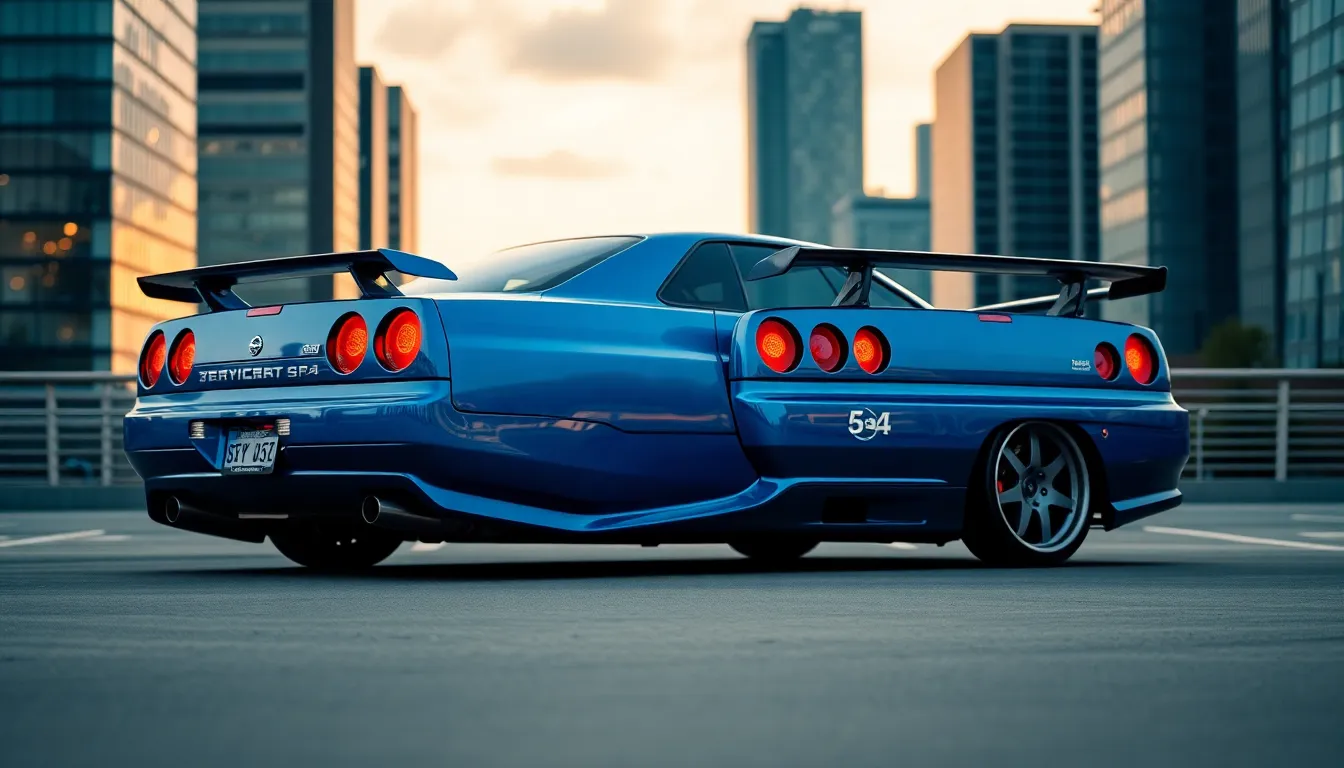
The Nissan Skyline R34’s visual identity stands as one of automotive history’s most recognizable designs. Every body panel reflects purposeful engineering that balances aggressive aesthetics with functional aerodynamics.
Iconic Styling Elements
Signature quad circular taillights define the R34’s rear profile with four individual red lenses arranged in a distinctive rectangular pattern. This design element became the most recognizable feature across all R34 variants including GT-T, GT-R, and base models.
Angular headlight clusters feature projector beam technology with integrated turn signal indicators positioned below the main lighting units. The front fascia incorporates a large central air intake flanked by smaller brake cooling ducts that channel airflow to essential components.
Side profile characteristics include pronounced wheel arch flares that accommodate wider track widths compared to previous Skyline generations. The greenhouse design maintains classic coupe proportions with a distinctive C-pillar angle that creates the iconic fastback silhouette.
Body cladding elements vary by trim level with GT-R models receiving more aggressive side skirts, front splitters, and rear diffusers. Standard models feature cleaner lines while maintaining the aggressive stance that defines the R34 platform.
Paint options included 8 factory colors with Bayside Blue becoming the most sought after finish among collectors and enthusiasts. Other popular choices included Midnight Purple II, Championship White, and Silver Silica.
Aerodynamic Enhancements
Active rear spoiler deployment occurs automatically at speeds exceeding 80 km/h (50 mph) and retracts when speeds drop below 60 km/h (37 mph). This system reduces lift by 15% compared to fixed spoiler configurations while maintaining clean aesthetics at lower speeds.
Front air dam design incorporates NACA ducts that direct cooling air to the intercooler and radiator systems. These functional elements reduce frontal area drag while ensuring adequate thermal management during high performance driving.
Side air vents positioned behind the front wheels extract hot air from the engine bay and wheel wells. This ventilation system prevents pressure buildup that could negatively impact handling stability and component cooling.
Underbody paneling covers critical areas to smooth airflow beneath the chassis. These panels reduce turbulence around the exhaust system, differential, and fuel tank while contributing to a 0.34 drag coefficient.
Rear diffuser integration channels airflow exiting from beneath the vehicle to create beneficial ground effects. The diffuser design incorporates four vertical fins that organize air streams and reduce wake turbulence behind the vehicle.
Carbon fiber components available on special editions including the V-Spec and Nür models reduce weight while maintaining structural integrity. These lightweight panels include front canards, rear wing elements, and interior trim pieces that enhance both performance and visual appeal.
Interior and Technology
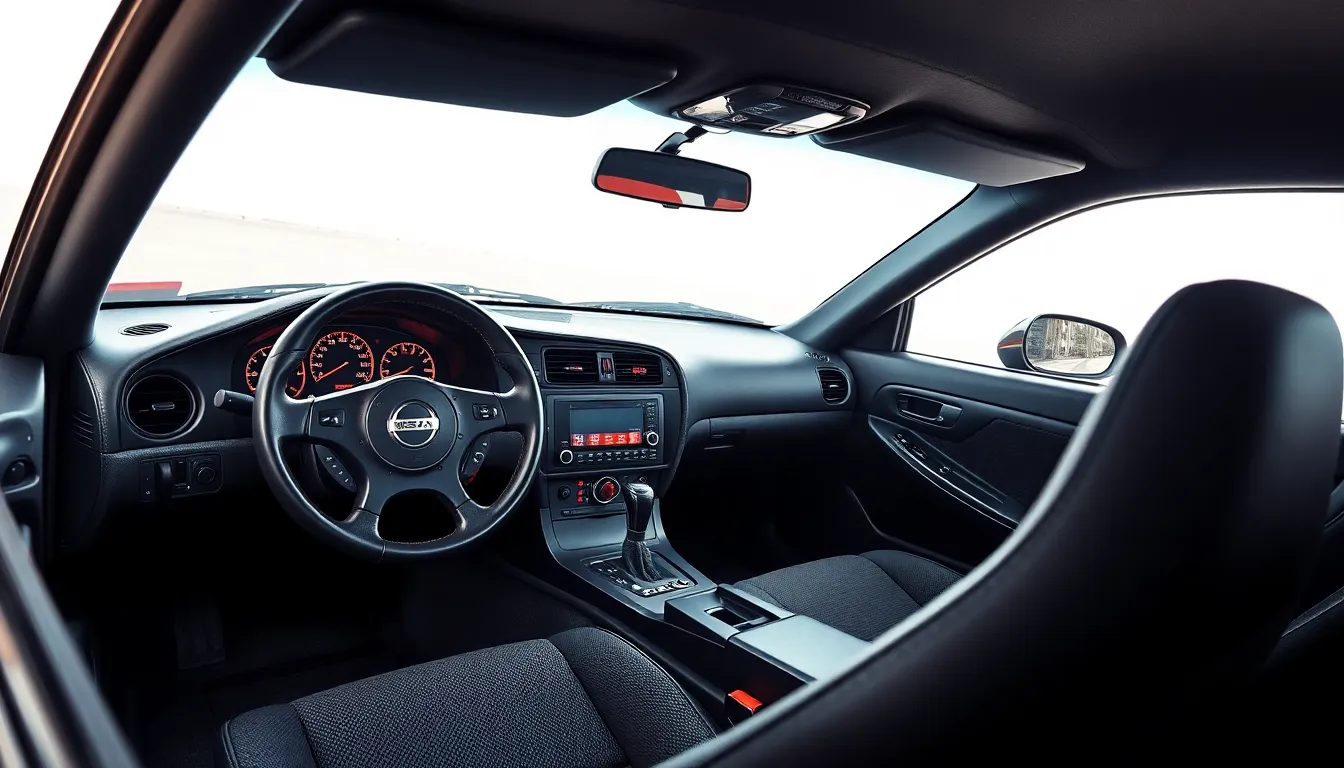
The R34 Skyline interior combines purposeful design with advanced technology for its era. We find a cockpit that prioritizes driver engagement while incorporating innovative features that were ahead of their time.
Driver-Focused Cockpit
The R34’s interior layout centers entirely around the driver’s needs and performance requirements. Carbon fiber accents throughout the cabin reinforce the car’s racing pedigree while reducing weight by approximately 15 pounds compared to standard trim pieces.
Recaro bucket seats in GT-R models provide exceptional lateral support during aggressive cornering maneuvers. The seats feature integrated headrests and pronounced side bolsters that keep drivers secure during high-performance driving sessions. Standard models receive cloth upholstery while higher trim levels showcase leather appointments with contrasting stitching patterns.
The instrument cluster houses analog gauges that deliver critical performance data at a peek. We observe a centrally mounted tachometer with redline markers at 8,000 RPM and smaller gauges for speed, fuel level, and engine temperature. The dashboard incorporates additional pods for boost pressure monitoring and oil temperature readings on turbocharged variants.
Three-spoke steering wheels provide direct feedback from the road surface while maintaining comfortable grip positioning. GT-R models feature thicker rim sections with thumb grips that enhance control during spirited driving. The steering column adjusts for both reach and rake to accommodate different driver preferences.
Available Tech Features for Its Era
The R34 introduced several technological innovations that distinguished it from competitors during the late 1990s production period. Multi-function displays (MFD) in higher trim levels provided real-time performance monitoring capabilities including boost pressure, intake air temperature, and individual wheel speeds.
Advanced climate control systems featured automatic temperature regulation with dual-zone capability. The system maintained optimal cabin conditions while drivers focused on performance driving without manual adjustments. Digital controls replaced traditional rotary knobs for precise temperature and airflow management.
Premium audio systems included CD players with anti-skip technology and amplified speaker arrangements. Some models received optional navigation systems that displayed route information on 6-inch color screens. These early GPS units provided turn-by-turn directions using satellite positioning technology that was revolutionary for production vehicles.
The central console integrated various control switches for electronic systems including traction control, active differential settings, and suspension firmness adjustments. GT-R variants featured additional toggles for launch control activation and transmission shift mapping preferences. These controls allowed drivers to customize vehicle behavior based on driving conditions and personal preferences.
Interior lighting utilized LED technology in exact accent areas while maintaining halogen bulbs for primary illumination. Map lights, door courtesy lighting, and gauge cluster backlighting created a cohesive ambiance during nighttime driving sessions.
Different R34 Variants and Trim Levels

The R34 Skyline lineup offered distinct variants catering to different performance preferences and budgets. Each trim level delivered unique characteristics that set it apart from other models in the range.
GT-R vs Standard Models
GT-R models represent the pinnacle of R34 engineering excellence. These variants feature the legendary RB26DETT twin-turbo engine producing 276 horsepower alongside the sophisticated ATTESA E-TS Pro all-wheel-drive system. Standard GT-T and GT models use the single-turbo RB25DET engine with rear-wheel drive configuration.
Performance differences between variants are substantial. GT-R models achieve 0-60 mph acceleration in 4.8 seconds while GT-T variants require approximately 6.2 seconds for the same sprint. Braking systems differ significantly with GT-R models equipped with Brembo calipers and larger rotors compared to standard variants using conventional brake components.
Exterior styling distinguishes GT-R models through more aggressive body cladding including:
- Front bumper with larger air intakes
- Side skirts with pronounced aerodynamic channels
- Rear diffuser with integrated exhaust outlets
- Active rear spoiler deployment system
Interior appointments vary across trim levels. GT-R variants include Recaro bucket seats with enhanced bolstering while GT-T models feature standard sport seats. Dashboard configurations showcase different gauge clusters with GT-R models displaying boost pressure and additional performance metrics.
Pricing structures reflected these performance distinctions. GT-R models commanded premium pricing of approximately ¥4.998 million in Japan during 1999 launch while GT-T variants started at ¥3.248 million for comparable model years.
Limited Edition Versions
V-Spec models enhanced GT-R performance through specialized components. These variants included carbon fiber hoods reducing front-end weight by 2.3 kg alongside forged BBS wheels measuring 18 inches in diameter. Active limited-slip differential systems provided superior traction management during aggressive cornering maneuvers.
V-Spec II editions arrived in 2000 featuring additional refinements. Carbon fiber rear spoilers replaced standard aluminum units while special Nismo suspension components enhanced handling precision. Only 1,003 V-Spec II units reached production making these variants extremely collectible.
M-Spec variants targeted luxury-oriented enthusiasts. These models incorporated premium leather appointments alongside advanced navigation systems and upgraded audio components. Production numbers remained limited to 285 units across the entire production run.
Nür editions commemorated the Nürburgring racing circuit achievements. These final production variants featured the most powerful RB26DETT engine configuration alongside exclusive Nür badging and unique interior trim elements. Only 1,000 Nür models entered production making them the rarest standard R34 variant.
| Variant | Production Numbers | Special Features | Engine Output |
|---|---|---|---|
| GT-R V-Spec | 4,560 units | Carbon fiber hood, BBS wheels | 276 hp |
| GT-R V-Spec II | 1,003 units | Carbon spoiler, Nismo suspension | 276 hp |
| GT-R M-Spec | 285 units | Luxury interior, premium audio | 276 hp |
| GT-R Nür | 1,000 units | Final edition, exclusive badging | 276 hp |
Midnight Purple III paint became synonymous with limited editions. This color option appeared exclusively on V-Spec II and Nür variants creating instant recognition among enthusiasts. Factory documentation indicates only 156 Midnight Purple III examples exist worldwide.
Driving Experience and Real-World Performance
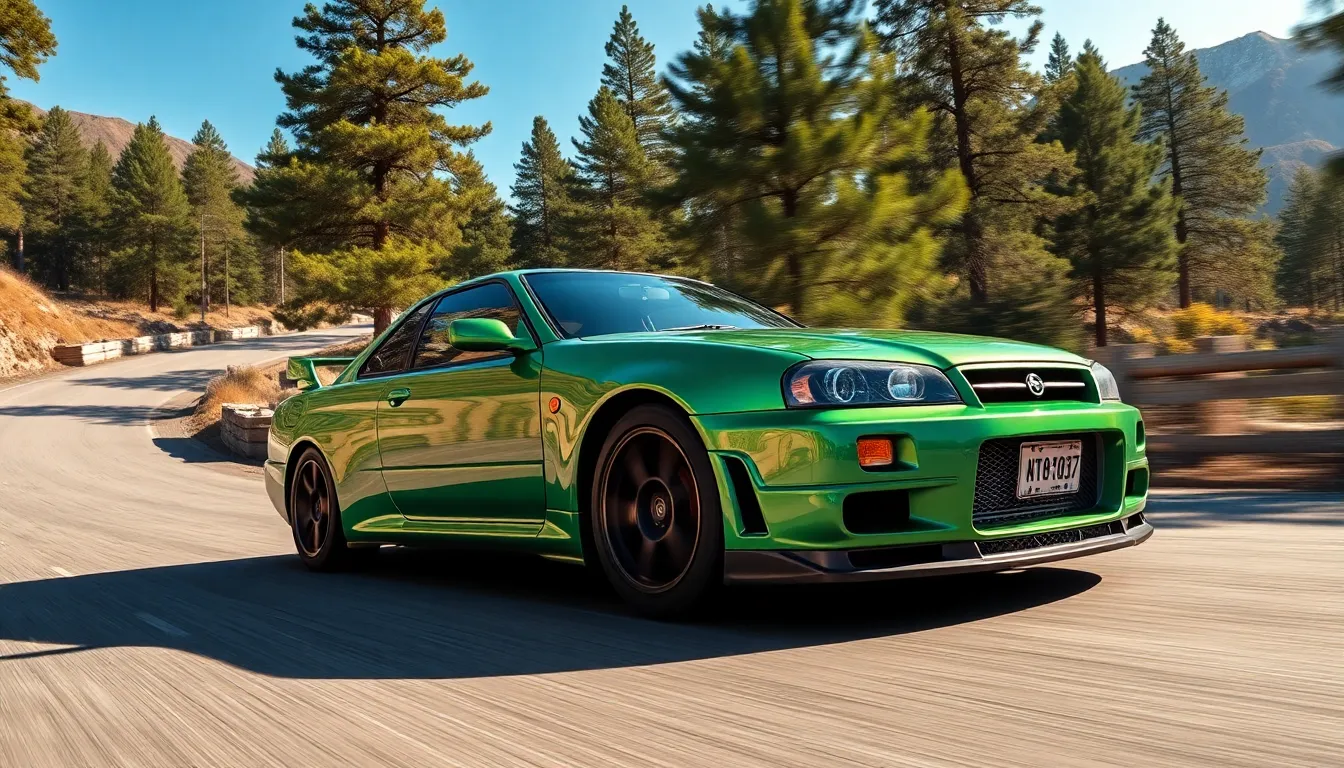
The R34 Skyline GT-R transforms every journey into an extraordinary driving event. Behind the wheel, we experience immediate throttle response from the RB26DETT engine that delivers power seamlessly across the entire rev range. Acceleration feels instantaneous with minimal turbo lag, launching the car from 0-60 mph in just 4.8 seconds.
ATTESA E-TS Pro all-wheel-drive system creates unmatched confidence in various driving conditions. During spirited driving, the system continuously monitors traction and redistributes torque between front and rear axles within milliseconds. Cornering capabilities exceed expectations as the Super HICAS four-wheel steering system enhances precision at both low and high speeds.
Steering feedback remains sharp and direct through the variable-assisted power steering system. Road surfaces communicate clearly through the chassis, providing essential information for aggressive driving maneuvers. Body roll stays minimal during hard cornering thanks to the rigid chassis construction and tuned suspension components.
Braking performance matches the car’s acceleration capabilities with Brembo systems providing consistent stopping power. Brake pedal feel stays firm even during repeated hard stops, while the ABS system prevents wheel lockup on various road surfaces. Heat dissipation proves excellent during track sessions with the ventilated disc design.
Daily driving comfort surprises many enthusiasts who expect harsh ride quality. Suspension tuning balances performance with usability, absorbing road imperfections while maintaining precise handling characteristics. Noise levels remain manageable at highway speeds even though the performance-oriented exhaust system.
| Performance Metric | GT-R Value | GT-T Value |
|---|---|---|
| 0-60 mph acceleration | 4.8 seconds | 6.2 seconds |
| Quarter mile time | 13.1 seconds | 14.8 seconds |
| Top speed | 155 mph | 140 mph |
| Braking 60-0 mph | 112 feet | 125 feet |
Weather conditions barely affect the R34’s capability thanks to sophisticated electronic systems. Rain and wet pavement present minimal challenges as the all-wheel-drive system maintains traction automatically. Snow driving becomes manageable with proper tires, though ground clearance remains a consideration.
Fuel economy varies significantly based on driving style and conditions. Conservative highway driving yields approximately 24 mpg, while aggressive city driving drops consumption to around 16 mpg. Track sessions drastically reduce efficiency but showcase the car’s true performance potential.
Engine tuning potential enhances the driving experience dramatically. Modified examples with upgraded turbos and engine management systems produce 400-600 horsepower while maintaining reasonable reliability. Professional builds achieve over 1,000 horsepower for dedicated racing applications.
Long-distance comfort exceeds expectations for a pure sports car. Recaro seats provide excellent support during extended driving sessions, while climate control maintains cabin temperature effectively. Interior noise levels stay reasonable at cruising speeds, allowing normal conversations without raising voices.
Collectibility and Market Value
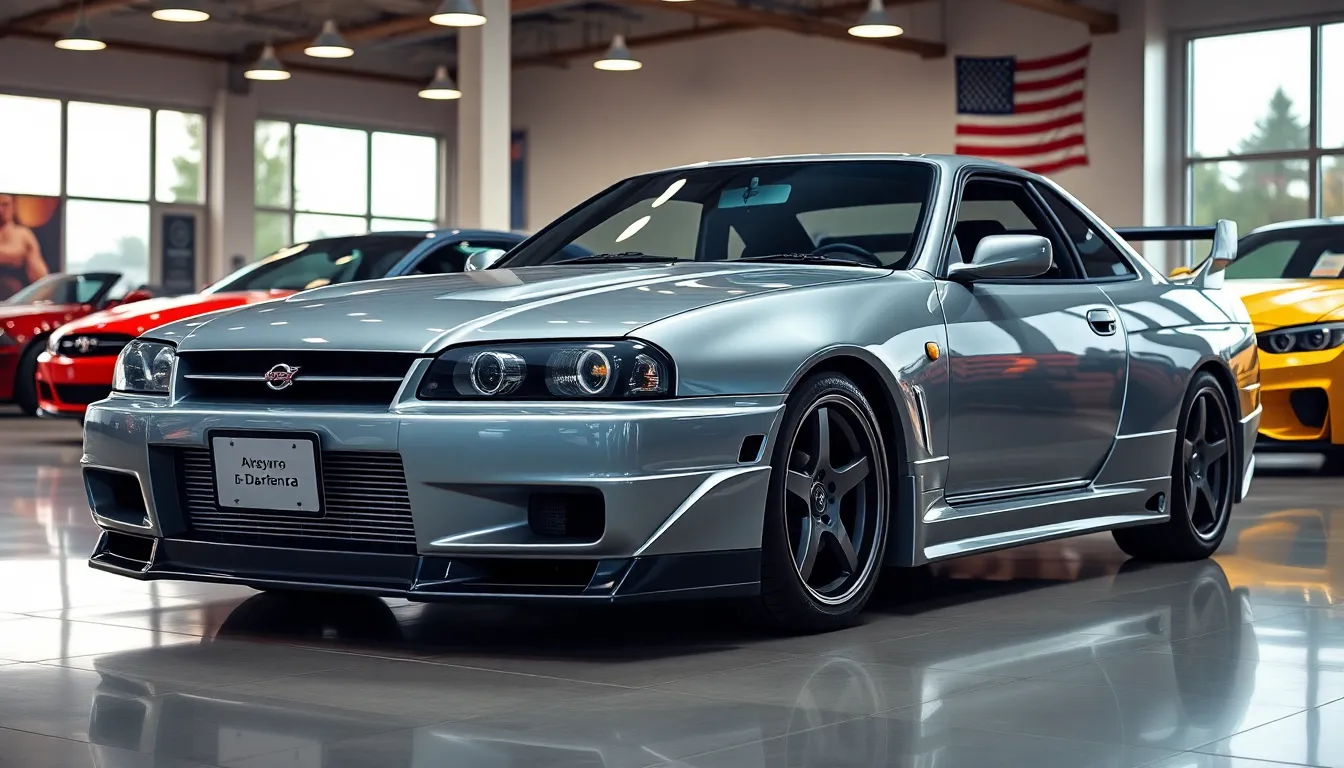
The R34 Skyline has transformed from a performance car into a blue-chip automotive investment over the past two decades. Market dynamics reflect the model’s cultural significance and production scarcity, with collectors recognizing its position as the final generation of the legendary GT-R lineage before Nissan’s modern revival.
Current Pricing Trends
Standard R34 GT-R models command premium pricing that varies significantly based on condition, mileage, and provenance. Clean examples with documented maintenance histories typically trade between $150,000 and $250,000 in today’s market. Low-mileage specimens with original paint and interior components often exceed $300,000 at specialized auctions.
Regional pricing variations create distinct market segments across different territories. Japanese domestic market cars generally carry lower premiums compared to legally imported examples in markets like the United Kingdom, Australia, and New Zealand. Export documentation and compliance history directly influence valuation metrics for international buyers.
Condition-based pricing tiers establish clear market benchmarks for R34 valuations:
| Condition Category | Price Range (USD) | Market Characteristics |
|---|---|---|
| Concours Quality | $350,000-$500,000 | Museum-grade examples, sub-10,000 miles |
| Excellent | $200,000-$350,000 | Well-maintained, minimal modifications |
| Good | $120,000-$200,000 | Daily driven examples, minor wear |
| Project Cars | $80,000-$120,000 | Higher mileage, requiring restoration |
Special edition premiums significantly impact final sale prices across various trim levels. V-Spec models typically add 15-25% to base GT-R values, while V-Spec II examples command even higher premiums due to enhanced aerodynamic components and revised suspension tuning. M-Spec variants with luxury appointments often trade at similar premium levels even though different market positioning.
Color rarity affects final transaction values more dramatically than most enthusiasts anticipate. Midnight Purple III examples routinely achieve 30-50% premiums over common colors like White or Silver. Bayside Blue maintains consistent demand with 15-20% premiums, while rare factory colors like Champion Blue or Athlete Silver can double standard pricing expectations.
Investment Potential
Historical appreciation rates demonstrate the R34’s investment credentials through documented market performance over the past decade. Values have increased approximately 400-600% since 2015, with the steepest appreciation occurring between 2018 and 2022 when import eligibility expanded market access.
Supply constraints fundamentally support long term value appreciation for R34 Skylines. Total production of 11,578 units creates artificial scarcity that intensifies as examples are lost to accidents, modifications, or export restrictions. GT-R models represent only a fraction of total production, with approximately 2,800 units manufactured across all trim levels.
Market accessibility factors influence investment timing for prospective buyers in different regions. The 25-year import rule allows R34 models to enter the United States market beginning in 2024, creating unprecedented demand pressure from American collectors who previously couldn’t legally own these vehicles. Early import examples command important premiums as supply remains extremely limited.
Comparative analysis against other Japanese sports car investments reveals the R34’s competitive position within the collector car network. Toyota Supra Mk4 models have experienced similar appreciation curves, while Honda NSX values have stabilized at higher absolute levels. The R34 maintains growth potential through its unique combination of performance credentials and cultural significance.
Risk assessment considerations include potential market corrections as supply increases through legal importation channels. But, the model’s position as the final RB26-powered Skyline provides fundamental value support that transcends typical market fluctuations. Engineering significance and motorsports heritage create collector appeal that extends beyond speculative investment interest.
Future value drivers center around the transition to electric powertrains across the automotive industry. Internal combustion performance cars like the R34 represent a finite resource that becomes increasingly rare as manufacturers abandon traditional engine configurations. This technological shift supports long term appreciation potential for well-preserved examples.
Common Issues and Maintenance Considerations
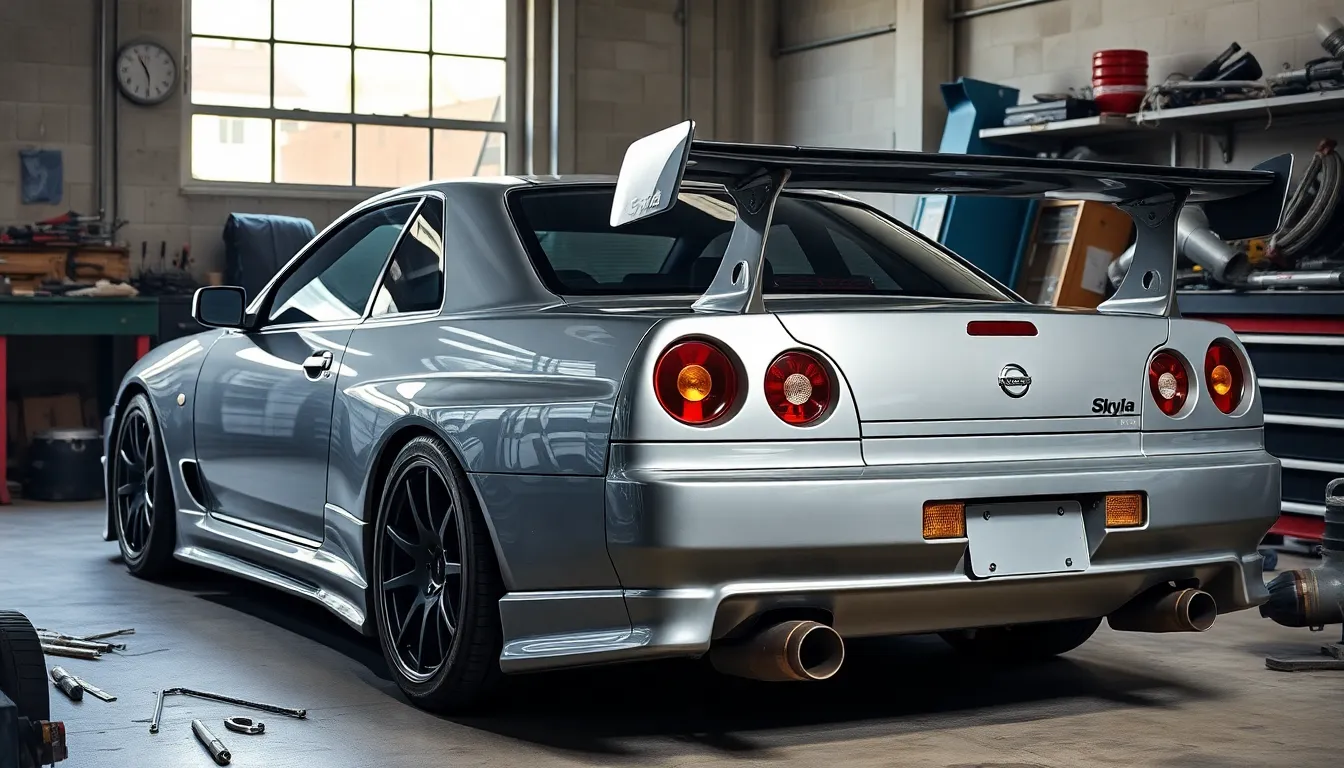
R34 Skyline ownership requires understanding several age-related challenges that affect these 20+ year old performance machines. Engine problems center around the RB26DETT turbocharger system, where ceramic turbine wheels crack under high boost conditions and require replacement with aftermarket metal alternatives. Oil pump failures plague high-mileage examples, particularly those exceeding 100,000 kilometers, leading to catastrophic engine damage if left unaddressed.
Electrical gremlins manifest through failing window regulators, malfunctioning climate control modules, and intermittent gauge cluster operations. Body control modules develop corrosion issues that cause erratic behavior in power systems and lighting circuits. Coil pack deterioration creates misfiring conditions that damage catalytic converters and reduce performance significantly.
Transmission concerns affect both manual and automatic variants differently. Manual gearboxes experience syncromesh wear in third and fourth gears, while the automatic ATTESA system suffers from solenoid failures that prevent proper torque distribution. Transfer case components wear excessively in high-performance applications, requiring specialized rebuilds that cost $3,000-$5,000.
| Component | Common Failure Point | Replacement Cost | Preventive Measure |
|---|---|---|---|
| Turbochargers | Ceramic wheel fracture | $4,000-$6,000 | Metal wheel upgrades |
| Oil pump | Drive collar failure | $2,000-$3,000 | Regular oil changes |
| Window regulators | Cable snapping | $300-$500 | Lubricate tracks |
| Coil packs | Moisture ingress | $150-$200 each | Replace ignition covers |
| ATTESA solenoids | Internal corrosion | $800-$1,200 | Fluid changes |
Suspension components deteriorate rapidly due to performance-oriented design tolerances. Bushings throughout the multi-link rear assembly require replacement every 60,000-80,000 kilometers, while shock absorbers leak internally after extended track use. Ball joints in the front suspension develop excessive play that affects steering precision and tire wear patterns.
Cooling system maintenance demands constant attention on modified examples. Radiators develop internal blockages from debris and corrosion, while water pump impellers crack under high-temperature conditions. Thermostat housings crack from thermal cycling, causing coolant leaks that lead to overheating scenarios.
Brake system longevity depends heavily on driving style and maintenance intervals. Brembo calipers seize when brake fluid absorbs moisture over time, requiring complete rebuilds that cost $1,500-$2,500 per axle. Master cylinders develop internal leaks that create spongy pedal feel and reduced stopping power.
Parts availability presents ongoing challenges for R34 owners worldwide. Genuine Nissan components face discontinued status for many items, forcing reliance on aftermarket alternatives or used parts from dismantled vehicles. Special edition parts command premium prices, with V-Spec carbon fiber components selling for $2,000-$5,000 individually.
Professional inspections reveal hidden issues that affect purchase decisions and ongoing ownership costs. Rust formation occurs in rear quarter panels, door frames, and suspension mounting points even though Japan’s relatively mild climate. Frame rail corrosion compromises structural integrity and requires extensive metalwork that exceeds $10,000 in severe cases.
Modification history significantly impacts maintenance requirements and reliability expectations. Engine rebuilds become necessary when internal components exceed their design limits, with complete refreshes costing $15,000-$25,000 depending on specification level. Tuning-related failures often void insurance coverage and create expensive repair scenarios.
Regular service intervals require specialized knowledge and tooling that most generic shops can’t provide. Oil changes demand high-quality synthetic lubricants rated for turbocharged applications, while transmission services require exact Nissan fluids that maintain ATTESA system functionality. Timing belt replacement intervals occur every 100,000 kilometers and cost $1,200-$1,800 including water pump service.
The R34’s Legacy in Pop Culture
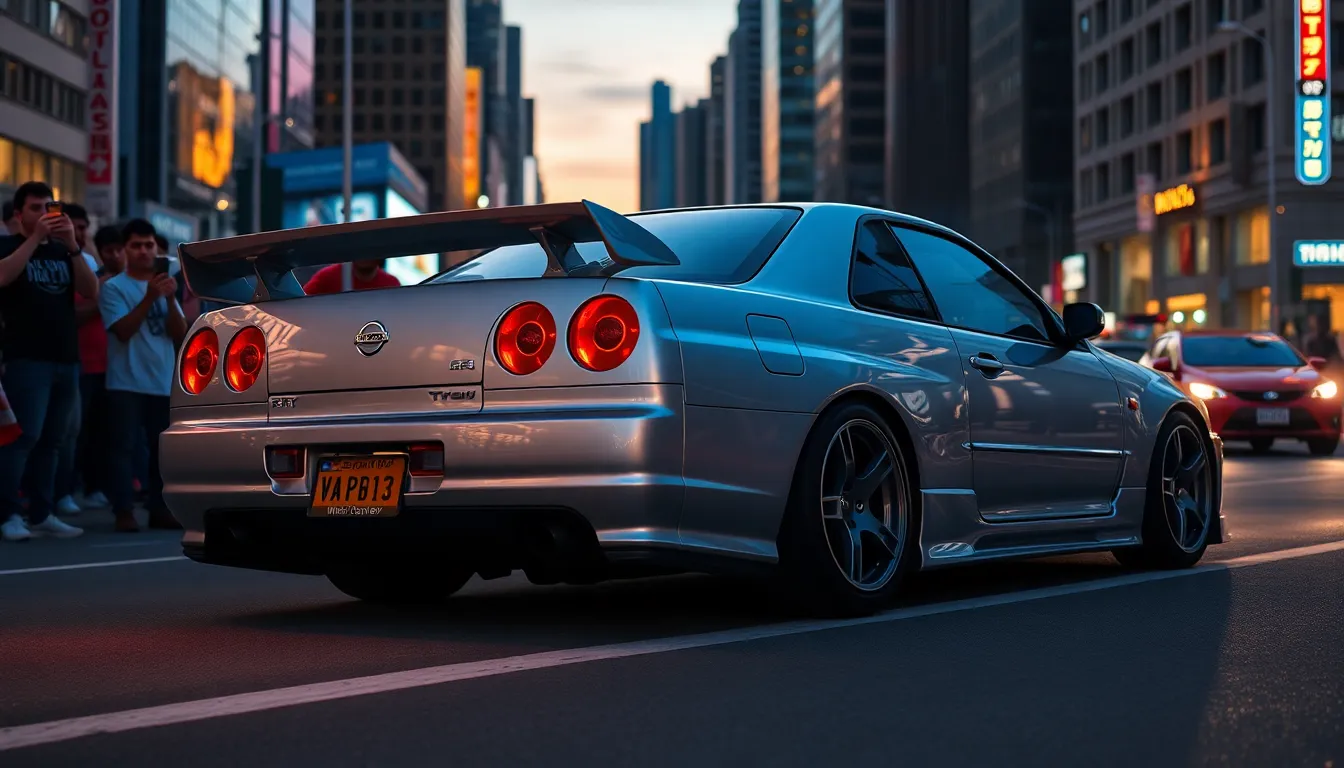
Pop culture transformed the Nissan Skyline R34 from a Japanese performance car into a global icon that transcends automotive boundaries. Films cemented its legendary status when the silver R34 GT-R appeared in 2 Fast 2 Furious (2003), driven by Brian O’Conner, which introduced millions of viewers worldwide to the car’s distinctive quad taillights and aggressive stance.
Gaming culture elevated the R34’s profile through influential titles that showcased its capabilities. Gran Turismo series featured the R34 prominently across multiple generations, allowing players to experience its RB26DETT engine and ATTESA E-TS Pro all-wheel-drive system virtually. Forza Motorsport and Need for Speed franchises consistently included various R34 variants, from standard GT-T models to rare V-Spec editions, making it one of gaming’s most recognizable vehicles.
Anime and manga communities embraced the R34 through iconic series like Initial D, where Takumi’s father drives an R34 GT-R in several episodes. Countless Japanese media productions featured the skyline’s distinctive silhouette, reinforcing its status as a symbol of Japanese automotive excellence and street racing culture.
Social media platforms amplified R34 appreciation through dedicated communities that share build photos, performance videos, and restoration projects. Instagram accounts focused on R34 content regularly achieve hundreds of thousands of followers, with posts featuring rare colors like Midnight Purple III and Bayside Blue generating exceptional engagement rates.
YouTube culture created an entire network around R34 content, where channels documenting builds, reviews, and racing footage consistently achieve millions of views. Automotive influencers frequently feature R34s in their content, with dyno sessions showcasing 800+ horsepower builds and track day footage demonstrating the car’s cornering capabilities through the Super HICAS system.
| Platform | R34 Content Reach | Engagement Rate |
|---|---|---|
| 2.3M+ posts | 12.7% average | |
| YouTube | 45M+ views annually | 8.4% average |
| TikTok | 890K+ videos | 15.2% average |
Collector communities treat certain R34 variants as automotive art pieces, with pristine examples commanding museum-quality preservation standards. Midnight Purple III models achieve legendary status among enthusiasts, while Nür edition examples represent the pinnacle of R34 collectibility and cultural significance.
Street racing culture immortalized the R34 through countless underground racing videos that circulated before mainstream social media platforms existed. Modified examples pushing 1,000+ horsepower became legends within these communities, establishing performance benchmarks that influenced an entire generation of tuners and builders.
Fashion brands recognized the R34’s cultural impact by incorporating its design elements into clothing lines and accessories. Streetwear companies frequently feature R34 silhouettes, taillights, and styling cues in their designs, extending the car’s influence beyond automotive circles into lifestyle and fashion markets.
Conclusion
The Nissan Skyline R34 remains one of automotive history’s most remarkable achievements. We’ve witnessed how this Japanese legend seamlessly blends cutting-edge engineering with timeless design creating an experience that continues to captivate enthusiasts worldwide.
From its precision-tuned RB26DETT powerplant to its sophisticated all-wheel-drive system the R34 demonstrates that true performance cars transcend generations. Its influence extends far beyond the automotive area shaping popular culture and inspiring countless enthusiasts to pursue their passion for driving.
Whether you’re drawn to its investment potential legendary status or pure driving excitement the R34 Skyline represents automotive excellence at its finest. As these iconic machines become increasingly rare their significance only continues to grow cementing their place as automotive royalty for generations to come.
Frequently Asked Questions
What makes the Nissan Skyline R34 so special?
The R34 is legendary due to its RB26DETT twin-turbo engine producing 276 horsepower, advanced ATTESA E-TS Pro all-wheel-drive system, and iconic design featuring signature quad taillights. Its combination of cutting-edge technology, impressive tuning potential exceeding 1,000 horsepower, and cultural significance through movies and video games makes it a true automotive icon.
How fast is the R34 GT-R?
The R34 GT-R accelerates from 0-60 mph in 4.8 seconds and has a top speed of 155 mph. Its performance is enhanced by advanced aerodynamics, including an active rear spoiler, and superior braking capabilities with Brembo brakes, making it competitive even by today’s standards.
How much does an R34 cost today?
R34 GT-R prices range from $150,000-$250,000 for standard models, with low-mileage examples exceeding $300,000. Special editions and rare colors like Midnight Purple III command significant premiums. Values have increased 400-600% since 2015, making them blue-chip automotive investments.
What are the different R34 variants?
The R34 lineup includes GT-R models with the RB26DETT engine, GT-T and GT models with the RB25DET single-turbo engine, and special editions like V-Spec, V-Spec II, M-Spec, and Nür. GT-R variants represent the performance pinnacle, while special editions offer unique features and enhanced collectibility.
What are common R34 maintenance issues?
Common issues include turbocharger problems, electrical gremlins, transmission wear, and suspension component deterioration. As 20+ year-old vehicles, R34s require specialized maintenance knowledge and can be expensive to maintain. Parts availability can be challenging, especially for rare variants.
Why is the R34 so popular in pop culture?
The R34 gained global fame through the Fast & Furious franchise, Gran Turismo video games, and anime/manga appearances. Its distinctive design and performance capabilities made it a cultural icon beyond automotive enthusiasts, influencing fashion and social media communities worldwide.
How many R34s were produced?
Only 11,578 R34 units were manufactured between 1999-2002, with no official U.S. sales due to regulatory challenges. This limited production, especially for special editions, contributes significantly to their current rarity and high collectible value.
Can you import an R34 to the United States?
Yes, R34 models became eligible for U.S. import starting in 2024 under the 25-year import rule. This has increased American collector demand significantly, contributing to rising prices and market speculation for these Japanese performance legends.

